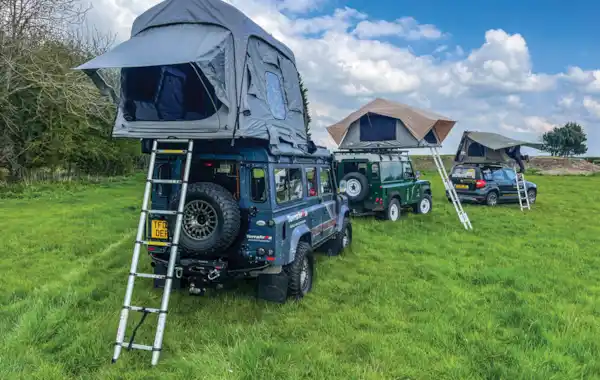26 May 2023
|
Thinking about buying a roof tent? LRM’s handy guide explains all
Look around at any Land Rover show, greenlaning run or spares day and it’s impossible to ignore the number of vehicles that have roof tents fitted. It’s not just 4x4s either; it’s now not uncommon to see smaller cars and vans cruising around with roof tents on top. The convenience of being able to park up and have somewhere comfortable to sleep in very little time at all is a tempting proposition, and with tents available from as little as £1100, roof tent life doesn’t have to break the bank.
If you aren’t au fait with what a roof tent actually is and how it works, let us explain. It does pretty much what it says on the tin – it’s a tent, that goes on the roof of your Land Rover. They generally mount on roof bars or a roof rack with brackets or clamps, and look sort of like a roof box when packed away. When you park up, the tent either folds or rises out of the ‘shell’, with a ladder that is then attached or extended down to allow you to climb up into the tent.
In the morning, simply fold or remove the ladder and pack the tent away again until your next adventure.
Things to think about
Having a home-from-home on top of your car might sound cool – because it is. But, as with every modification, there are some things to think about.

Clearance can be a problem with a roof tent fitted
Let’s get the downsides out of the way first. While a roof tent might not affect the ability of a ‘normal’ car to get in and out of carparks and under height restrictions, even the sleekest versions – combined with a roof rack or bars – will bump up a Land Rover’s height significantly. And if you regularly use a multi-storey or other carpark that has a height barrier, that might be a problem.
As with anything you carry on your roof, expect fuel economy to suffer slightly. Some roof tents are lower in profile than others when stowed, and so the impact can be lessened by choosing a more aerodynamic model. The extra weight on top of the vehicle will also affect handling, but not drastically.
Of course, you can remove the tent when you know you’re not going to use it, which solves all of the above issues. A popular method of storage is hanging the tent from the roof of a garage or car port with ratchet straps, so it can be lifted and lowered on and off the vehicle easily.
Anyway, onto the good points. For a start, having your accommodation stored on top of the roof means you free up space inside the Land Rover for more passengers and kit. It also means that if the weather is inclement – not unheard of in the UK – you’re not having to bundle a soggy, muddy ground tent into your pride and joy.
Being up on top of the vehicle is also a boon if you plan to travel further afield to countries which have wild animals that you may want to stay out of harm’s way. You also don’t really need to worry about looking for a pitch that’s uneven or rocky, as long as it’s fairly level – you’ll have a comfy sleep wherever you park.

Femkes Alu Khosi roof tent folds easily out of its aluminium shell (see our top tent picks below)
Convenience is a huge factor with a roof tent. While some types can take a little bit longer than others to put up, they are almost all faster and less stressful than setting up a ground tent. With minimal poles and in some cases just a couple of clips to release, roof tents really do make a lot of sense, especially if you often arrive at camp after dark and have more important things to worry about such as getting the barbecue lit.
Most roof tents have built-in mattresses, and some allow you to store bedding and other soft items inside the tent when it’s packed down. This is not only helpful from a space point of view, but everything you store inside will be kept clean and dry. If space is an issue inside the tent itself, and it rarely is, most roof tents come with the option of adding an awning or other zip-on living area, giving extra room for relaxing, eating and storing things like mucky boots.
Finally, a roof tent will make you the envy of your campmates. There’s a certain satisfaction of being the first one around the fire with a tasty beverage in hand, safe in the knowledge that you’ll also probably be sleeping in the most comfort when bedtime comes around. The views you get from your elevated position can also be absolutely stunning, meaning you wake up to a real treat in the morning.
What type of roof tent is best for you?

Hard or soft shell? Either will give you a sound night’s sleep
With so many roof tent options on the market, it can be difficult to know which to go for.
There are two main types of roof top tents: hard shell and soft shell. Hard shell tents are stored in a solid box made of durable materials such as fibreglass or aluminium, and are designed to fold out easily into a sturdy, comfortable sleeping space.
Soft shell tents, on the other hand, are folded into a soft bag made of waterproof fabric and are typically slightly lighter and more compact, and therefore easier to attach to your vehicle. Both types of tents have their advantages, so it's important to choose the one that's right for you based on your camping needs and vehicle size.
Hard Shell
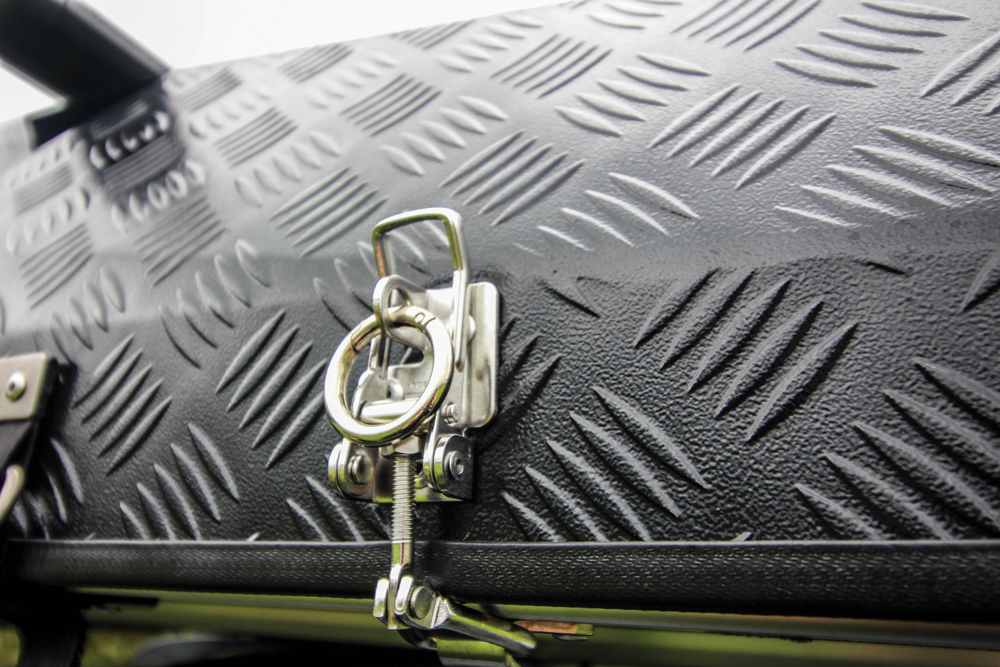
Lockable latches secure the tough outer shell closed
Hard shell rooftop tents are becoming increasingly popular among campers, and for good reason. These tents are made with a sturdy outer shell that's designed to withstand harsh weather conditions and brush off glances from foliage, which is a bonus if you’re partial to tight greenlanes. When not in use, the tent folds up into a compact unit that sits on top of your vehicle. When you're ready to set up camp, simply pop the tent open, add any poles or extensions, and climb inside.

Shell is lifted and supported by twin gas struts
One of the main benefits of a hard-shell roof tent is its durability. These tents are typically made from high-quality materials that are built to last. The outer shell is usually made from tough, weather-resistant material which pops up on gas struts, while the inner tent is made from a breathable fabric such as canvas or polyester. The combination of these materials ensures that you stay dry and comfortable in any weather conditions.

Flexible poles simply hook in to support outer rain cover
Hard shell rooftop tents also tend to be more aerodynamic than their soft counterparts, which can improve your vehicle's fuel efficiency. Additionally, many come with built-in features such as lights, storage pockets, and even solar panels.
Of course, there are some downsides to hard shell rooftop tents. For one, they tend to be more expensive than soft shells, and they can be heavier as well. Additionally, some models can be more difficult to set up and take down, especially if you're doing it alone – but this Femkes Alu Khosi is exceptionally easy.
Check out more details on the Femkes Alu Khosi at: https://rooftentutopia.com/product/femkes-alu-khosi-roof-tent/
Soft Shell

With outer cover removed, the tent folds open on hinges
Soft shell roof tents are the more traditional option, and have been a popular choice among campers for many years. These tents are made from a soft, flexible material such as canvas or nylon, and they fold up into a compact unit that sits on top of your vehicle. When stowed, a weatherproof cover goes over the top to keep them dry. When you're ready to set up camp, simply remove the cover and unfold the tent. With a bit of practice, they can be set up in a couple of minutes.
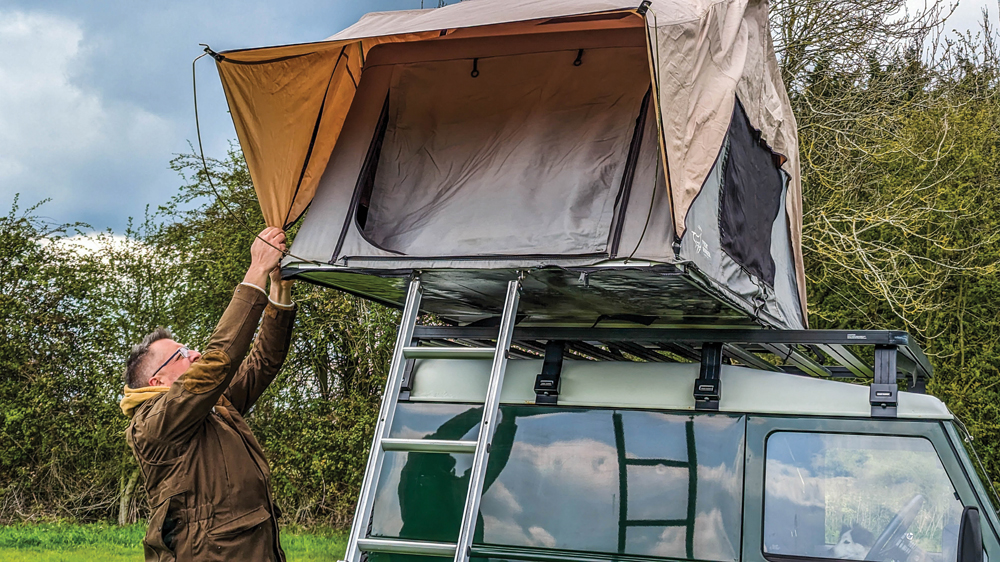
With most soft shell tents, the opening can be positioned either to the side or rear of the vehicle
One of the main benefits of a soft-shell roof tent is its affordability – the FrontRunner Outfitters tent seen here weighs in at just £1,129. These tents tend to be less expensive than the hard-shell option, which makes them a great option for campers on a budget. Additionally, soft shell tents are typically lighter and more compact, with a smaller footprint when stowed, which can be important if you need extra space on your roof rack to store other items.

Poles are kept to a minimum with either type of roof tent
Many models also come with built-in features such as mosquito nets and ventilation panels, which can help you stay comfortable and bug-free throughout the night.
Of course, there are some downsides to soft shell rooftop tents as well. For one, they tend to be less durable than hard shell tents, which means they may not hold up as well in harsh weather conditions, and can be trickier to store as they don’t seal up as tightly as a hard-shell, which means moisture and rodents can find their way inside if not stored correctly.
Read more about the FrontRunner soft-shell at: https://www.frontrunneroutfitters.com/en/uk/front-runner-roof-top-tent.html
ALTERNATIVE ROOF TENTS
In recent years, new technical innovations have been introduced to the roof tent market, designed to make them even easier to use. Although some people used to consider products such as electric and inflatable tents as gimmicks, they are quickly gaining popularity and proving that they can make camping even easier.
Electric roof tents

Quick and easy set-up with the electric motor (inset)
Electric roof tents are a relatively new addition to the roof top tent market. They are fitted with an electric motor that allows for easy and quick set up and take down at the push of a button. This type of roof top tent is perfect for those who want the convenience of a roof top tent without the hassle of manually setting it up. Electric roof top tents are typically made with hard-shell materials, which provides more protection from the elements and offer better insulation.
One thing to consider when choosing an electric roof top tent is the power source. Most models require a 12V power source, which can be obtained from your Land Rover's battery. However, this can drain your battery quickly if you are not careful.
Inflatable roof tents
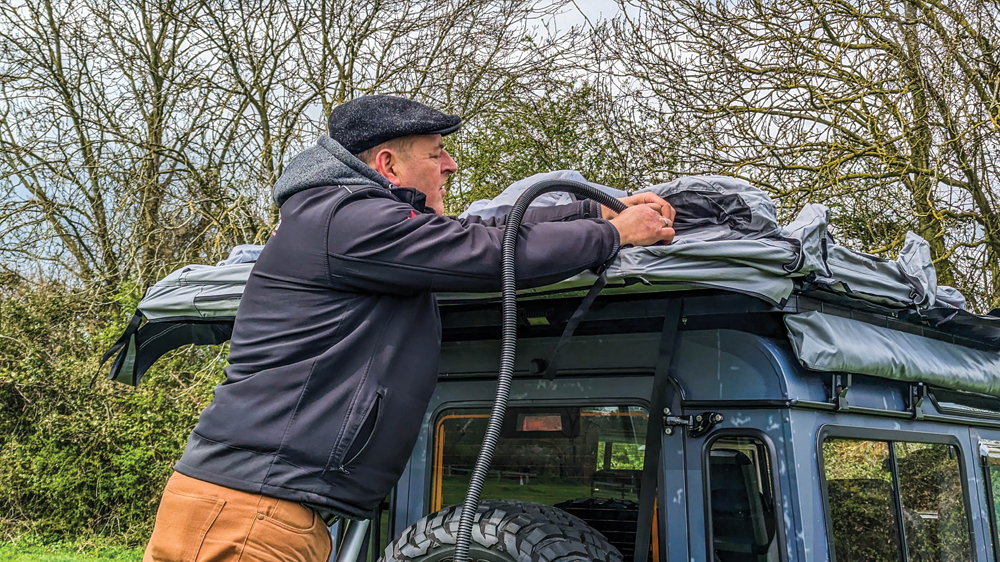
Terrafirma tent is inflated easily with the included pump
Inflatable roof top tents – such as the Terrafirma TF1710 Expedition seen here – are another innovative addition to the roof top tent market. They are made with durable materials that can withstand the elements and are inflated with a manual or electric pump. Inflatable roof top tents are typically lighter in weight than traditional roof top tents and can be set up and taken down quickly.
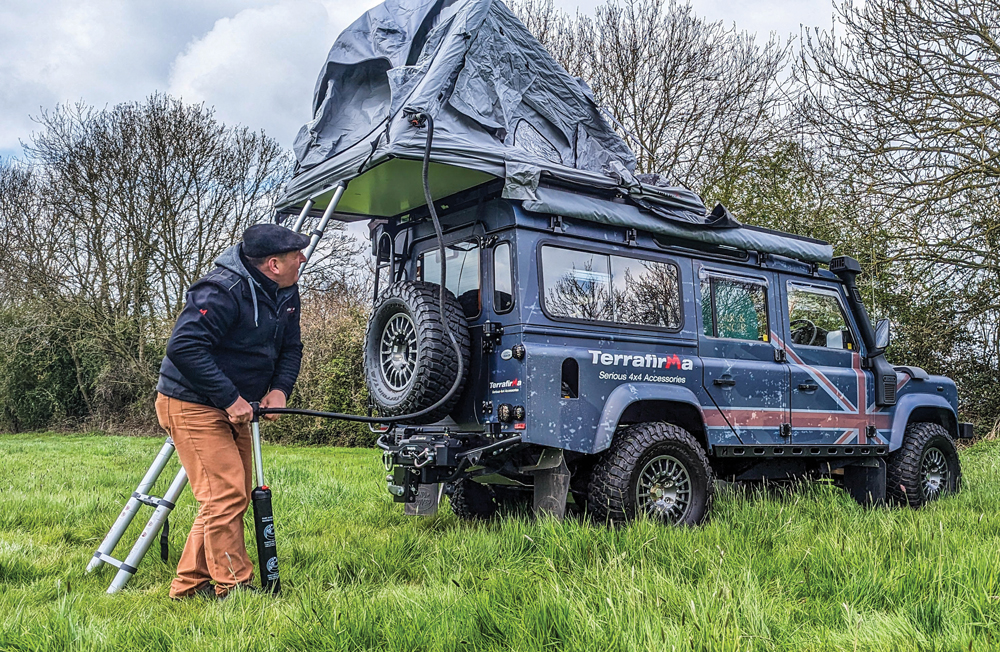
Inflatable tents tend to weigh less and have a small footprint
One of the main advantages of inflatable roof top tents is their ease of use. They can be inflated in just a few minutes, which makes them perfect for those who are short on time or who want to avoid the hassle of manually setting up a traditional roof top tent. However, they do require a bit of extra care to ensure they are not damaged during use.
For more info on Terrafirma’s inflatable roof tent, head to:
How do I fit a roof tent?
The two main factors to consider are that you have a roof rack or bars fitted that are the correct distance apart to suit the tent model, and that your vehicle is capable of supporting the combined weight of the tent, its cover and the roof bars or rack.
Before you begin fitting a roof top tent to your Land Rover, it's important to make sure that your roof can safely support the weight of the tent. The roof load capacities – both dynamic and static – must be greater than the weight of the roof tent you’re thinking of putting on top.
Check your owner's manual for weight limits, and recommended roof bar systems. If you’re unsure, consult with a professional as it’s very important you don’t exceed the appropriate limits.

Extra weight can put a strain on roof rack and suspension
The dynamic roof load limit is the maximum your Land Rover can carry while it is being driven, and it takes into account the potential effect on the vehicle’s handling and risk of rolling as well as how much weight the roof can handle.
As the handling and roll risk are irrelevant when you’re parked up, it’s only the static load capacity that matters. The static load limit is considerably higher than the dynamic load, because the vehicle isn’t subject to the same pressures as it would be when on the road, so there’s no need to worry about the weight of people in your roof tent. Generally, they can easily accommodate two large adults sleeping inside.
Once you've determined that your vehicle is capable of supporting a roof top tent, you'll need to choose a roof bar or rack system that's compatible with your vehicle and tent. Some manufacturers offer roof mounts specifically designed for their tents, while others may require a universal system. Make sure to choose a system that's appropriate for the fixings on your vehicle, and rated for the weight of your tent and any additional gear you plan to bring along.
When installing the roof system, always follow the manufacturer's instructions carefully. Once the roof bars or rack are in place, you can lift the tent into place (you’ll need some assistance) and attach it to the rack using the manufacturer's recommended method. This may involve using straps, clamps, or other hardware.
Driving with a roof tent

You will need to take a little more care when driving
If your Land Rover’s suspension springs, dampers, bushings and tyres are in good condition, a roof tent shouldn’t make a huge difference to your driving experience but there are a few points to take into consideration.
Roof tent manufacturer TentBox recommends that your speed should be restricted to 70mph when a roof tent is fitted to your vehicle, which is, of course, the national speed limit for dual carriageways and motorways in the UK. You will still need to stick to 70 if you’re driving on the Continent, even though speed limits are higher.
TentBox also warns that because of the increased centre of gravity, the weight of the roof tent may affect cornering, cruising speed and acceleration. There will be slight impact on fuel consumption as well, but the aerodynamic design of most roof tents means that is minimal. Strong cross winds may affect your car’s handling, especially on exposed roads.
Using a roof tent
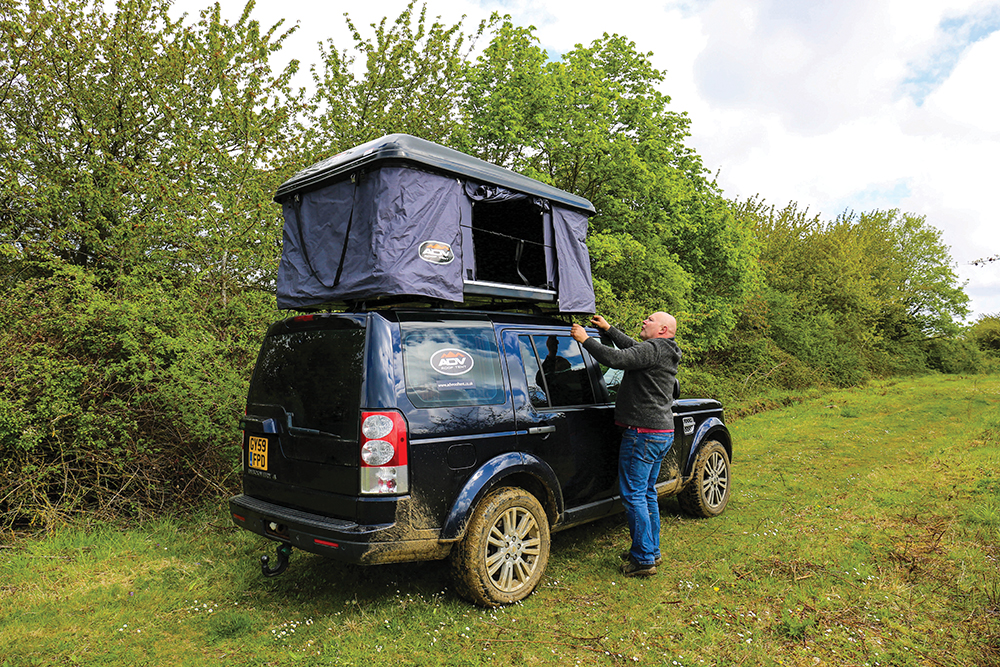
Get to know how your roof tent sets up
Once your roof top tent is installed, you're ready to hit the road. Here are some tips for using it:
• Practice setting up and taking down the tent before you leave on your camping trip. This will help you get familiar with the process and ensure that you're comfortable with the tent's features.
• Be sure to check weather conditions before you set up the tent. High winds or heavy rain can make setting up the tent more difficult or even dangerous.
• When parking your Land Rover with the roof top tent, choose a level surface that's free of obstacles. This will make it easier to set up the tent and ensure a comfortable sleeping experience.
• Be mindful of weight distribution when packing for your camping trip. It's important to evenly distribute weight throughout the vehicle to ensure safe driving conditions
Why not try one?
If you love the idea of a roof tent but aren’t sure if you want to take the plunge just yet, why not hire one for a holiday and see what they offer before you buy? Electric Explorers, based in the Lake District, hire tents out that can be fitted to your own Land Rover.
Website: https://www.electricexplorers.co.uk/hire-rooftop-tents/
Call: 07514385394
Email: [email protected]
OUR TOP TENT PICKS
Hopefully by now you have an idea of what kind of roof tent suits you best. Here is a selection of our favourites to help get your started on a journey to true camping freedom.
Femkes Alu Khosi

Type: Hard-shell
Sleeps: 2
Stowed footprint: 159x125x27cm
Features: 2mm aluminium shell, integrated roof bars, anti-condensation mattress, 3 stprage bags, additional awning canopy, fly sheet, anti-theft bolts, telescopic aluminium ladder, 2-year warranty
Weight: 68kg inc. ladder
Available from: rooftentutopia.com, 07566 792690, [email protected]
Price: £3,399
Thule Approach M
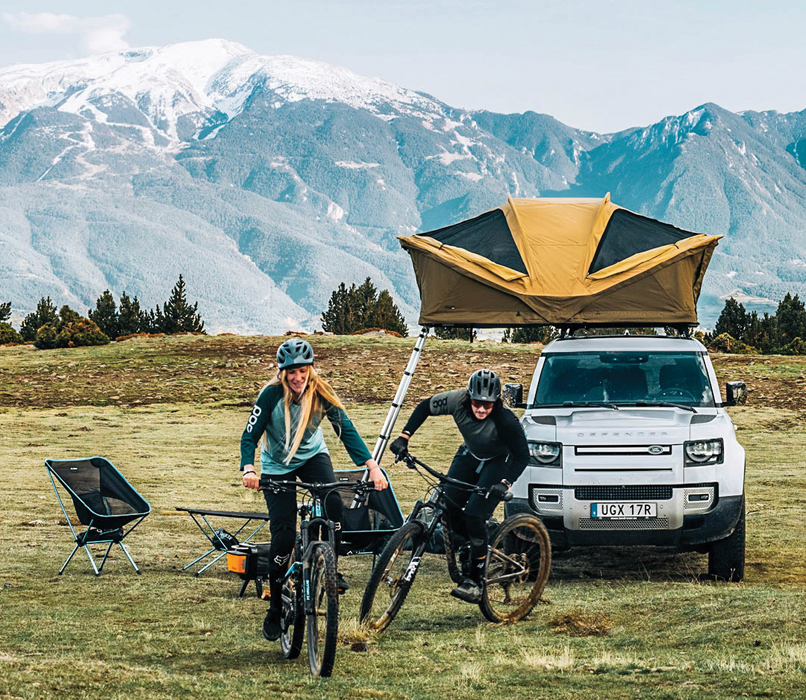
Type: Soft-shell
Sleeps: 2-3
Stowed footprint: 143x124x28cm
Features: Panoramic skylights, removable rain cover, mosquito screens, dual-layer foam mattress, quick-release lockable mounting brackets, choice of colours
Weight: 58kg
Available from: thejourneycentre.co.uk, [email protected], 01143 493550
Price: £2499.99
Terrafirma Expedition TF1710
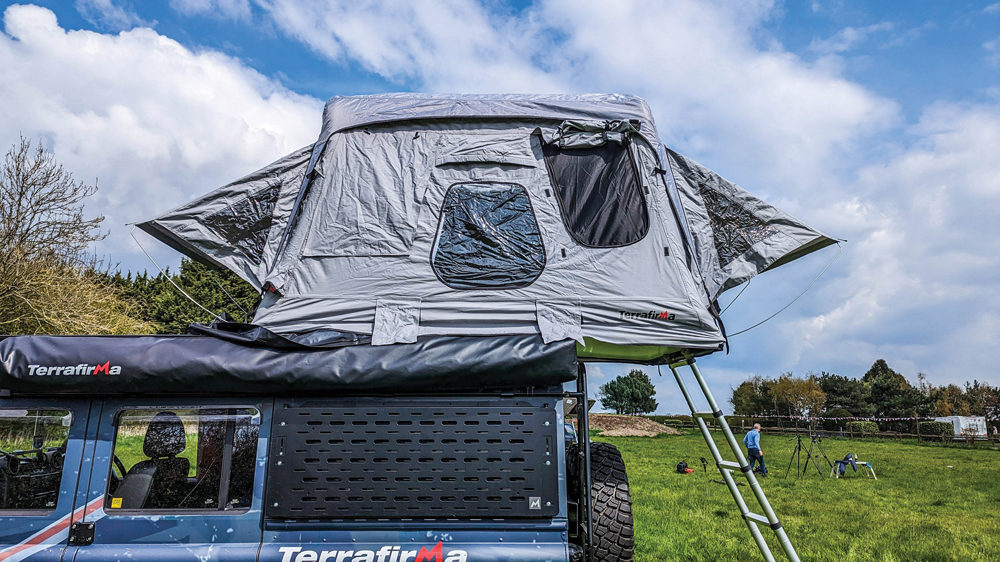
Type: Inflatable
Sleeps: 2
Stowed footprint: 150x80x26cm
Features: Small roof footprint, 90mm inflatable tubes, inflatable mattress, PVC windows, high performance pump. 2.3mm extendable ladder, vinyl cover, mounting kit included
Weight: 62kg
Available from: maltings4x4store.co.uk, [email protected], 01427753394
Price: £1669.99
Roofbunk Roamer

Type: Hard-shell
Sleeps: 2-3
Stowed footprint: 210x140x27cm
Features: Streamlined shell, stainless steel gas struts, removable telescopic ladder, two access doors, 7cm foam mattress, interior storage net, fitting kit
Weight: 65kg
Available from: roofbunk.com, [email protected], 07940900614
Price: £1749
LIKE TO READ MORE? Try our Budget Digital Subscription. You'll get access to over 7 years of Land Rover Monthly – that’s more than 100 issues plus the latest digital issue. The issues are fully searchable so you can easily find what you are looking for and what’s more it’s less than 10p a day to subscribe. Click here to find out more details and start enjoying all the benefits now.







